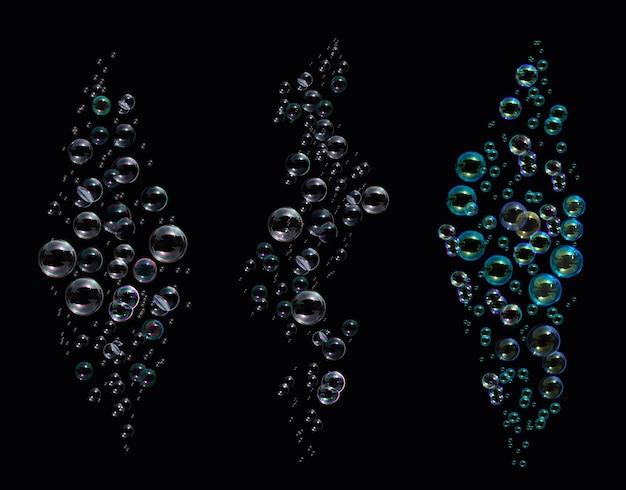Have you ever noticed small water bubbles forming on your ceiling? It can be quite alarming to see these mysterious bubbles appearing out of nowhere. Don’t worry though, you’re not alone in this predicament. Many homeowners have encountered this issue and wondered what causes it and how to fix it. In this blog post, we will explore the possible reasons behind these bubbles in your ceiling plaster, discuss how to fix them, and provide tips for preventing their occurrence. So, let’s dive in and find out all there is to know about those pesky water bubbles on your ceiling!
Small Water Bubbles on Ceiling
Have you ever walked into a room and noticed small water bubbles on the ceiling? You might think you’ve stumbled upon a funky art installation or a secret message from the universe. But no, my friend, those tiny water bubbles are a clear sign that something funky is going on with your ceiling. Let’s dive into this watery mystery and find out what’s causing these intriguing little bubbles!
The Culprit: Moisture Buildup
Ah, moisture, the villain behind countless home issues. It turns out that tiny water bubbles on the ceiling are often a result of moisture buildup. This can happen due to various reasons, such as excessive humidity in the room, a leaky roof, or even a plumbing issue in the floor above. So basically, your ceiling is throwing a little water party, and those bubbles are the VIP guests.
The Mold Brigade
Believe it or not, those water bubbles can also attract some uninvited guests: mold and mildew. Yep, the party doesn’t stop! Moisture is the perfect breeding ground for these pesky intruders, and they can quickly take over your ceiling if not dealt with promptly. So not only do you have some unconventional ceiling art going on, but you also have potential health hazards lurking above your head. Fun, right?
DIY Detective Work
Now that you know the suspects, it’s time to play detective and determine the cause of the water bubbles. Start by checking for any signs of leakage above the affected area. Are there any pipes running through the ceiling? Is your roof in good condition? If you can’t spot any obvious sources of water, it might be time to call in the professionals and let them unleash their Sherlock Holmes skills.
Bursting the Bubble
To fix this oh-so-fascinating issue, you’ll need to address the root cause: moisture. Repair any leaks, invest in a dehumidifier, and make sure your room is properly ventilated. Once you’ve tackled the moisture problem, you’ll need to deal with the aftermath—the mold and mildew. Consult with experts on the best ways to remove and prevent these unwelcome visitors from returning.
Prevention: Bubble-Free Ceilings
Now that you’ve painstakingly solved the mystery and restored order to your ceiling, it’s time to take some preventive measures. Keep an eye on the humidity levels in your home, especially during those wet and rainy seasons. Inspect your roof regularly to catch any potential issues before they turn into bubble-generating monsters. And don’t forget to maintain proper ventilation to keep your ceilings bubble-free and your room smelling fresh as a daisy.
In conclusion, small water bubbles on the ceiling may be fascinating to admire, but they’re also a sign that something is amiss in your humble abode. Take action, address the moisture buildup, bid farewell to the mold brigade, and prevent future bubble invasions. Your ceiling will thank you, and you can finally enjoy a bubble-free, mold-free living space once more. Happy bubble-busting!
Bubbles in Ceiling Plaster: A Quirky Encounter
What’s That Popping Sound
Imagine this: you’re lying in bed, peacefully drifting into dreamland, and then suddenly, you hear it. A soft, rhythmic popping sound coming from above your head. Confused, you look up, and to your horror, you spot small water bubbles on the ceiling. What on earth could have caused this quirky phenomenon?
The Anatomy of a Bubbling Ceiling
Let’s dive into the delightful world of bubbles in ceiling plaster. These playful formations occur when trapped moisture gets trapped beneath the surface of the plaster layer, leading to the formation of delightful bubbles. It’s like having a miniature bubble wrap on your ceiling, minus the satisfying popping sensation.
A Moisture Mystery Unveiled
Now that we know the culprits behind these captivating ceiling bubbles, it’s time to unravel the mystery of how the moisture found its way there. As it turns out, several factors can contribute to this peculiar phenomenon. Leaky pipes, condensation, or even excessive humidity in the room can all play a part in the bubble party happening above your head.
Bid Farewell to Foam Fest
Don’t fret, for there are ways to bid farewell to these frothy intruders. The first step is to identify the source of moisture, fix any leaks, and ensure proper ventilation in the room. Once you’ve tackled the root cause, it’s time to address the bubbles themselves. Gently puncture the bubbles with a small needle or pin, allowing the trapped moisture to escape. But remember, safety first! Protect yourself from falling droplets by placing a bucket or cloth beneath the bubble.
Prevention for Bubble Bliss
Prevention is always better than cure, and the same holds true for bubbles in ceiling plaster. To bask in the bliss of bubble-free ceilings, ensure proper insulation to avoid condensation buildup. Adequate and regular ventilation will also help to keep excess moisture at bay. And don’t forget to keep an eye out for potential leaks in your plumbing system – they can be sneaky culprits causing bubble mayhem.
A Burst of Laughter and Relief
While small water bubbles on the ceiling may initially seem like a cause for concern, we hope this mischievous encounter has brought a smile to your face. By understanding the root causes and taking preventive measures, you can bid farewell to these whimsical ceiling companions. So go forth, armed with knowledge and a sharp pin, and conquer the bubble trouble once and for all!
How to Get Rid of Those Pesky Ceiling Bubbles
Step 1: Assess the situation
So, you’re minding your own business, enjoying a quiet evening at home, when suddenly you spot them: small water bubbles on your ceiling. Don’t panic – this is a common issue that many homeowners face. Take a moment to examine the bubbles and try to determine the cause. Is it a leaky pipe? Roof damage? Or maybe just some dampness in the air? Understanding the root cause will help you tackle the problem head-on.
Step 2: Channel your inner handyman
Now that you’ve identified the source of the problem, it’s time to put on your DIY hat. If you’re anything like me, the mere thought of home repairs gives you a rush of adrenaline (or maybe it’s just fear). Either way, fixing these ceiling bubbles is not as intimidating as it may seem.
Step 3: Gather your tools
Before you embark on your ceiling repair adventure, make sure you have all the necessary tools at your disposal. You’ll need a ladder, a utility knife, some adhesive, a putty knife, sandpaper, and some paint to match your ceiling. Oh, and don’t forget your trusty sense of humor – it’s a crucial tool for any DIY project.
Step 4: Burst those bubbles (figuratively speaking)
Now, it’s time to get down to business. Use your utility knife to carefully pop the bubbles, creating a clean, smooth surface. Just be careful not to damage the surrounding area – we don’t want to turn this into a comedy of errors.
Step 5: Adhere and smooth
Apply some adhesive to the underside of the bubble and use your putty knife to gently press it back into place. Smooth out any excess adhesive and make sure the bubble is securely reattached to the ceiling. You’re starting to look like a pro now!
Step 6: Sand and paint
Once the adhesive has dried, grab your sandpaper and lightly sand the repaired area until it’s nice and even. Wipe away any dust and then apply a fresh coat of paint to blend the repair seamlessly into the rest of the ceiling. Voila! You’ve conquered the bubbles like a champ.
Step 7: Prevention is better than cure
To prevent future bubble outbreaks, it’s essential to address the underlying issue. If it’s a leak, fix the pipe or call a professional plumber. If it’s a more significant problem like roof damage, enlist the help of a roofing expert. Remember, a little prevention goes a long way in maintaining a bubble-free ceiling.
So there you have it, my friend – a comprehensive guide to fixing those small water bubbles on your ceiling. Now you can confidently tackle this home repair project with a dash of humor and a touch of finesse. Remember, while it may seem daunting at first, you’ve got this! Happy bubble-bursting!
Huge Water Bubble in Ceiling
So you thought small water bubbles on the ceiling were a nuisance? Well, get ready to meet their bigger and badder cousin – the huge water bubble in the ceiling. Picture this: you’re chilling on your couch when you suddenly glance up and see a giant, quivering bubble of water staring back at you. Cue the panic!
What Causes These Monsters to Form
The formation of a huge water bubble in the ceiling is often a result of a more serious underlying issue. It’s like that one kid in school who always causes trouble and brings chaos wherever they go. In this case, the culprit is usually a leaky pipe or roof, and that water has found its way into your ceiling, causing it to bubble up like a cartoon character getting ready to burst!
The Growing Menace
Unlike their small counterparts, huge water bubbles are not to be taken lightly. They have a mind of their own and can grow to massive proportions, making your ceiling resemble an alien landscape. The longer you leave it untouched, the bigger the bubble becomes, until one day it finally decides to unleash a chaotic downpour on your living space. Talk about suspense!
What to Do When You Encounter This Monstrosity
First things first, don’t panic! It’s tempting to run around like a headless chicken, but that won’t solve anything (plus, it’s not a pretty sight). Instead, follow these steps to handle the situation like a boss:
1. Assess the Situation
Take a moment to evaluate the size and severity of the bubble. Is it still growing, or has it reached its full potential? Knowing what you’re dealing with will help you decide the next course of action.
2. Call in the Professionals
While you might feel like the hero who can save the day, it’s best to call in a professional to handle this mess. They have the skills and experience to safely locate and fix the source of the problem, ensuring the bubble doesn’t return in the future. Leave it to the experts, and sit back and relax (well, maybe not relax just yet).
3. Protect Your Belongings
As the bubble could burst at any moment, it’s crucial to move any valuable or delicate items out of harm’s way. Don’t let that antique vase or your collection of porcelain kittens suffer the same fate as your ceiling. Find them a safe spot and keep your fingers crossed.
4. Play the Waiting Game
With the professionals on their way, there’s not much left to do but wait. The suspense is real, like watching a nail-biting season finale of your favorite TV show. Will they arrive in time to save the day? Only time will tell.
So the next time you encounter a huge water bubble in your ceiling, remember to stay calm and call in the experts. These monsters may bring chaos into your life, but with the right approach, they can be defeated. Just try not to get too attached to the suspense – after all, we’re not writing a thriller novel here.
Bubble on Ceiling but No Water
What’s the Deal with Bubble on Ceiling but No Water?
So, you’ve noticed a bubble on your ceiling and your first thought is, “Oh no, water damage!” But hold on just a minute – sometimes a bubble on your ceiling doesn’t necessarily mean water is to blame. Let’s dive into the amusing world of bubbles without water on the ceiling!
Not Everything that Bubbles is Water
While bubbles on the ceiling often make us think of water damage, there are actually a few other potential culprits. One common explanation for bubbles is simply improper application of paint. If the paint wasn’t applied evenly, air pockets can form underneath, creating those amusing little dome-like shapes on your ceiling. It’s like your ceiling is saying, “Hey, I’ve got personality!”
Holes, Holes Everywhere!
Another reason behind bubbles on your ceiling, believe it or not, is holes. Yeah, you heard that right. Holes in your ceiling can lead to air becoming trapped between layers, and voila, bubbles are born! It’s like your ceiling is playing hide-and-seek with you, except it’s not very good at hiding.
The Wrath of Humidity
Now, let’s talk about everyone’s favorite thing – humidity. Excess moisture in your house can contribute to bubbles forming on your ceiling, even without any water damage. Humidity can do some strange things, huh? It’s as if your ceiling wants to join in on the hot and sticky weather and show off its bubble-making skills.
Popping Bubbles: Should You Worry?
So, you’ve got a bubble on your ceiling, but there’s no water involved. Should you be concerned? Well, it’s not necessarily a major issue, but it’s worth checking out. If you have no experience with fixing bubbles, it’s best to leave it to the professionals. They’ll be able to determine the cause and provide expert advice on how to fix it. Maybe you can even convince them to perform a bubble-popping show – now that would be entertaining!
Conclusion
Remember, not all bubbles on the ceiling mean water damage. Sometimes, the painted surface just didn’t adhere properly, or there may be some sneaky holes lurking above. And let’s not forget our friend humidity, which can turn the ceiling into a bubble-blowing connoisseur. While it may not be a huge concern, it’s always best to have a professional take a look. Who knows, maybe they’ll even make a spectacle out of popping that bubble!
What Does a Ceiling Leak Look Like
So, you’re sitting in your cozy little living room, sipping on a cup of hot chocolate, and minding your own business when suddenly, you notice something strange above you. Drip, drip, drip—water is falling from the ceiling! And you start to wonder, “What does a ceiling leak look like?” Well, my friend, buckle up because we’re about to embark on a leaky adventure!
Signs of Trouble
Let me tell you, a ceiling leak isn’t always as obvious as a water park raining down on your head. Sometimes, it starts with innocent little water bubbles on the ceiling. These tiny troublemakers emerge like mini volcanoes, threatening to burst at any moment. If you spot these little water-filled warriors, it’s a telltale sign that something fishy is going on above you.
The Art of the Water Stain
Oh, but that’s not all! Ceiling leaks often come with an artistic touch—a water stain masterpiece. These water stains can take on various shapes and sizes, like abstract art gone wrong. You might end up with an unintentional Rorschach test on your ceiling, trying to decipher if it looks more like a fluffy cloud or a misshapen fried egg. But here’s the deal, my friend: no matter how much you squint, it’s never a pleasant sight.
The Dreaded “Squish Test”
Picture this: you’re a detective, on the hunt for evidence of a ceiling leak. One of the oldest tricks in the book is what I like to call the “Squish Test.” You gently press your finger against the suspicious bubble or stain on your ceiling, and squish! If water starts oozing out like a cheeky prankster, then congratulations, Sherlock, you’ve discovered a leak!
Prying Eyes
Now, keep in mind that not all leaks reveal themselves in such obvious ways. Sometimes, the culprits hide behind plaster or drywall, like elusive ninjas of the plumbing world. So, if you notice any sagging or discoloration in your ceiling, it’s worth investigating further. Get your magnifying glass out, channel your inner detective, and try to spot any subtle changes that might give away the leaky secret.
The Final Curtain Call
Remember, my friend, a ceiling leak can cause more damage than just a spoiled paint job or a damp carpet. If left unchecked, it can lead to mold growth, structural damage, or even a ceiling collapsing on your head (and trust me, that’s not a good look for anyone). So, the moment you suspect a ceiling leak, it’s time to take action and call in the professionals before things escalate.
And there you have it! The next time you spot those mischievous water bubbles or strange stains on your ceiling, you’ll know exactly what you’re dealing with. It might not be the most pleasant experience, but at least you’ll have a good story to tell—just make sure to fix the leak before you start telling it! Stay dry, my friend.
Why Do I Have Water Spots on My Ceiling but No Leak
It’s Raining (Water Spots) Men, Hallelujah!
So, you wake up one fine morning, stretch your arms, yawn with satisfaction, and boom – you spot water spots on your ceiling. Surprise, surprise! You didn’t invite these unwanted guests to your home, did you? Well, fret not, my puzzled friend, because your ceiling is just getting into a playful mood. It’s not leaking; it’s just having a party with its own mini-water bubbles. How considerate of your ceiling, right?
The Condensation Conundrum
Let’s get a bit serious, but not too serious, okay? The truth is, your ceiling may be experiencing a phenomenon called condensation. No, it’s not developing a chill personality, but rather, it’s collecting moisture from the surrounding air. You see, when warm, moist air hits a cool surface (like your ceiling), it forms these tiny drops of water, causing those lovely water spots. It’s like your ceiling is sweating, but without the yoga pants and the workout.
Who Needs a Leak When You Have Poor Ventilation
Now, before you start accusing your ceiling of being a prankster, let’s talk about another culprit – poor ventilation. If your bathroom or kitchen doesn’t have proper ventilation, all that steam from your showers and cooking adventures can’t escape, resulting in a moisture-filled room. And guess who loves moisture? Yep, your ceiling. So it throws a party with water spots to let you know it’s time to get that exhaust fan fixed. Talk about being a diva and making a statement!
Water Spots: Friends with Ceilings, Enemies with Leaks
You may have breathed a sigh of relief, thinking you’ve avoided a leaky disaster. But beware, my friend, for those innocent-looking water spots might actually disguise the presence of a hidden leak. It’s like a game of hide and seek – only, you’re not the one hiding, your water pipes are. So if those water spots persist or if you start hearing suspicious dripping sounds, it’s time to call in the professionals. The leaky culprit may be playing a game of cloak and pipe-dagger with you.
The Bottomline: Take Action and Save the Ceiling Party
Just because your ceiling is having a watery party doesn’t mean it wants to go on forever. Drip, drip, drip – that’s its way of saying, “Help me, I’m drowning in my own dampness!” So, be a good homeowner and remedy the situation. Improve the ventilation, fix any leaks you find, and make sure your ceiling can dry off properly. Once you’ve done that, your ceiling will toss confetti instead of water spots, and your happiest home will remain drip-free. Cheers to that!
Keyword: water spots on ceiling, no leak, condensation, poor ventilation, hidden leak



